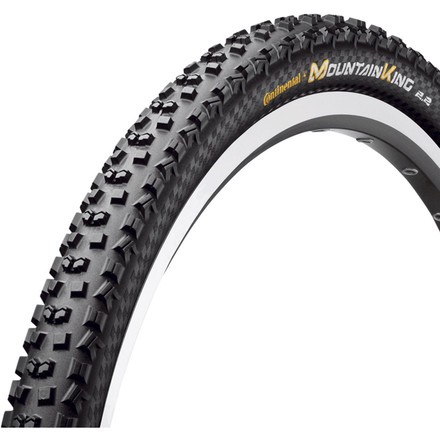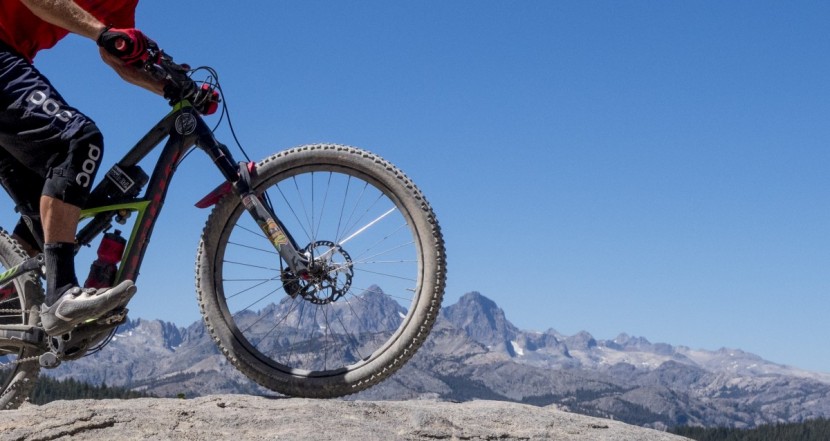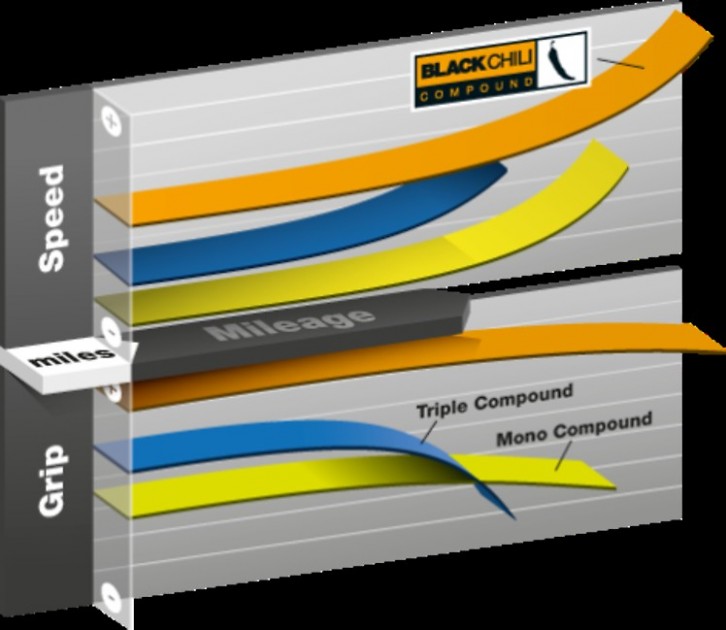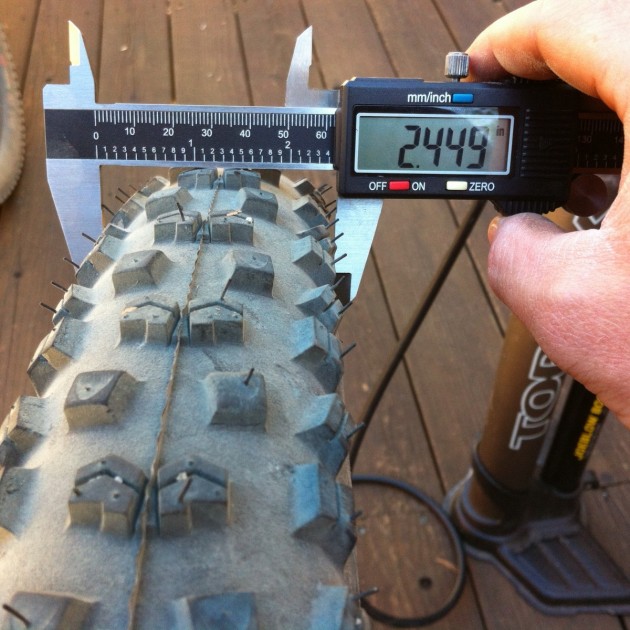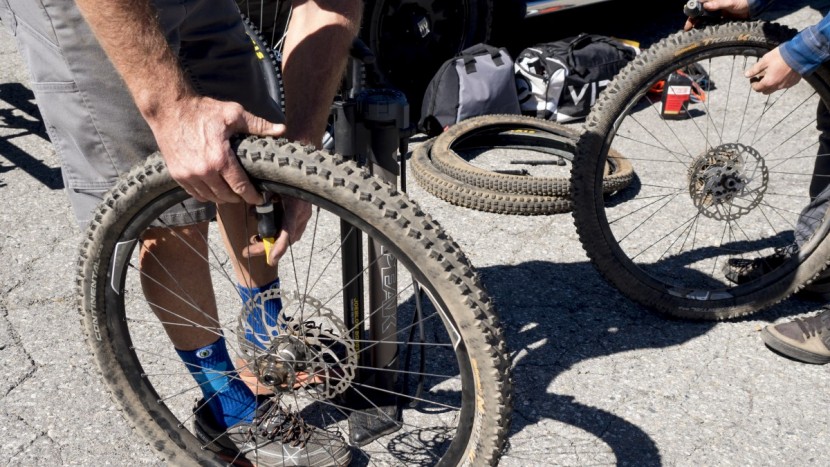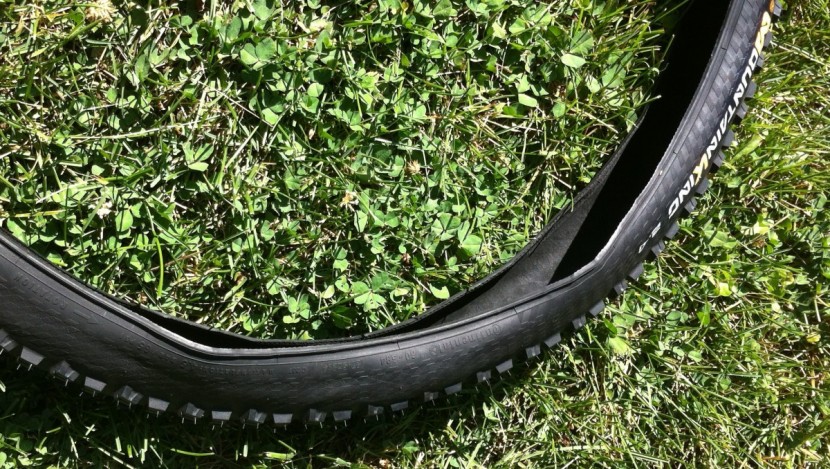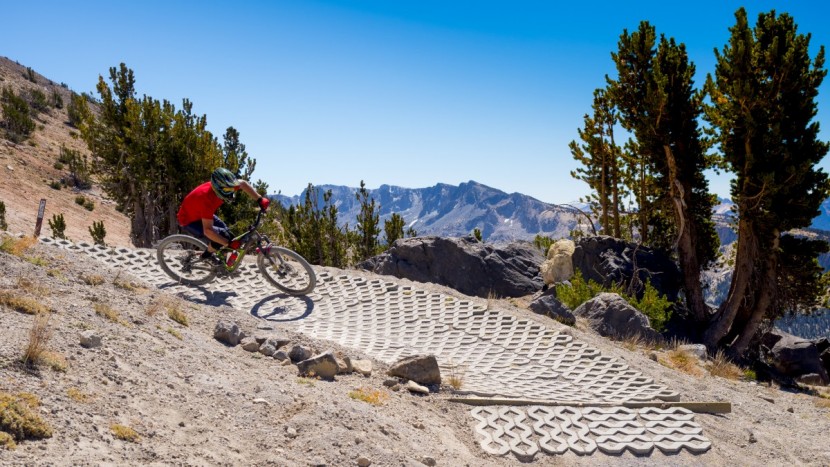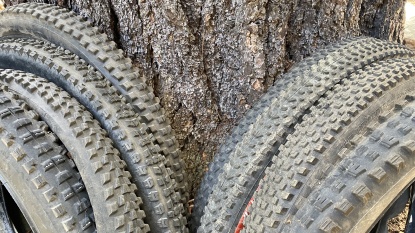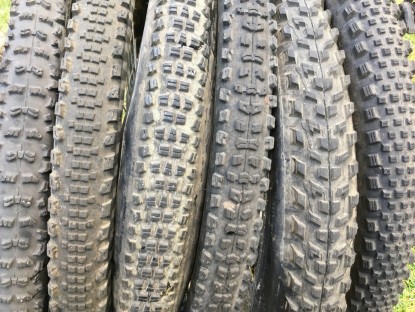Continental Mountain King 2.4 Protection Review
Our Verdict
Our Analysis and Test Results
The stats look good for the Mountain King; 820 grams, four layers of puncture resistance Protection, more grip. longer lifespan, less drag. We tested this tire in the 2.4-inch width. Continental recommends this tire in this size as an all-mountain tire best fitted to a 130-160mm bike. Our bikes were at the upper limits of this designation, with the Trail King and Baron recommended for freeride/enduro use.
With the aggressive knob size, we expected the tire to weigh a lot more. We think they saved weight by skimping on knobs because they are quite spaced out. We attributed the very drifty feel of this tire as it transitioned from center to size tread to the distinct channel created by this knob spacing. Straightline traction on the center tread is like Velcro and the same can be said for the side. It's the in-between that left us a bit worried. If the rider doesn't overexaggerate their bike angulation, the tire wants to slide and drift until we revert back upright or continue to lean the bike over. Other tires in this test, such as the Maxxis Minion DHF and Specialized Butcher have a much smaller transition zone.
Cornering Traction
For very aggressive, knee scraping, bar dragging riders, these tires hold tenacious grip when tipped way over onto the side knobs. The transition zone on this tire can be downright spooky if you don't blast through it in a hurry. When looking at this tire from above, the first thing we noticed was that there simply didn't seem to be a lot of knobs. The center tread is a tight-packed W-shaped dual knob divided down the middle and horizontally siped using a broad V-shaped sipe. Alternating the W-shaped center knobs are wider spaced singular square knobs. These knobs are not siped but are imprinted with what appears to be the Continental logo that adds a small amount of texture to the face of the knob.
Between these knobs and the side knobs lies a wide swath of nothingness. This rift between knobs creates a distinct channel that was often intimidating to cross. It took commitment. In dry, dusty conditions when we all end up feeling like we are terrible bike riders, we prefer a little more hand holding. This feeling will surely be too much for some riders to handle and as such, we would recommend the more predictable Maxxis Minion DHF or the WTB Vigilante.
During the late summer when a majority of our testing took place, we saw little (read absolutely zero) precipitation on our Tahoe trails and conditions were as dry and blown-out as possible. The large void on the tread of this tire seemed to exacerbate the lack of traction in these conditions. Our impressions changed with the seasons. Once we started seeing our breath on morning rides and the aspens that lined the singletrack blazed orange and yellow, we finally got some rain. The gratuitous knob spacing allowed mud to shed from the tires faster than hair sheds from the author's scalp. Yes, we realize pretty much every tire feels better when the dirt is better. However, no other tire in our test presented with such split personalities.
Just as with the Trail King, we felt a lack of support from this tire's casing. It felt very sensitive to different tire pressures. Again, we felt we often resorted to running a higher than desired tire pressure in order to provide adequate support and prevent the tire from squirming beneath us during hard cornering. We actually preferred to run this tire tubed for the additional support that setup offered.
Pedal Traction
Good. But for a pure pedaler, we'd probably recommend the Continental Trail King. Square edges on the knobs allow for exceptional bite. Continental attests that the Black Chili compound has a “30 percent higher friction value (grip).” We couldn't validate any kind of numbers in our field testing but the Continentals were among our favorite climbers in the test. Despite their relatively knobby appearance that we felt makes them look slow, one of our testers did manage to snag a new Strava KOMs running this tire on the front. Who can argue with an app that regularly grants an extra mile and discounts minutes from your buddy's ride despite the fact that he struggled to keep pace with you?
When things get slippery, you'll be less likely to notice because the Black Chili compound definitely likes to grab and go. Rocks, roots, wet leaves, whatever. By blending natural and synthetic rubber compounds using nanotechnology, the surface of the tire is basically coated with a smooth layer of small, symmetrically sized rubber molecules. This layer provides increased surface area which increases grip.
Braking Traction
This tire has lots of braking traction. There is plenty of space for dirt to jam up in. The grip we experienced on the way up worked just as well on the way down. The rounded profile of this tire and the Black Chili compound gripped to rock faces quite well instead of deflecting or skittering when we grabbed too much brake. The most central knobs are siped and feature square edges that churn up dirt with the lightest tap of the lever. Again, ample space between knobs let the tire clear itself of debris before getting caked up.
Rolling Resistance
Continental ran some tests and claims their Black Chili compound reduces rolling resistance by a whopping 26 percent. We don't run power meters on our bikes because that's such a roadie thing to do, but that's a pretty significant reduction. For such a knobby tire, we were surprised by how much it didn't feel like an anchor. Come to think of it, 820 grams for a 240 TPI tire? Impressive. From the looks of it, we expected this tire to be a bit more sluggish like the Michelin Wild Grip'r Advanced. Rather, we'd throw it in the mix with the Maxxis Minion DHF or the WTB Vigilante. Along with this tire, these would be a great aggressive front tire to run with something a little smoother and faster in the back to balance things out.
Longevity
Continental isn't afraid to claim it. A five percent increase in tread life is attributed to the use of Black Chili compound. Again, with a smoother rubber surface, that means the ground will be tearing less and less rubber from the tire with each rotation. We had a poor experience with our test Trail King but our Mountain King held up much better, though it was run as a front tire for most of the time and therefore subjected to far fewer pedaling forces.
We also had no issues with sidewall durability as we did with the Continental Trail King. This was a balloonish tire as well and the sidewalls sure took a beating squeezing through places but never sliced or deformed. With four plies of 60 TPI adding up to a whopping 240 TPI under the tread, we had no puncture problems plowing over thorn bushes on our test laps. Sidewalls have just one less layer of protection, using a triple layer for 180 TPI and a textured race flag design. We do feel the pudgy midsection is a little exposed to potential damage but made it through testing without a problem.
Installation
The Revolution Tubeless Ready bead with a foldable aramid core was one of the more temperamental to install. Unpacked, the bead was slow to take on its shape of a perfect circle and benefited from a little time in the sun. In all but perfect environmental conditions, we usually needed a few tries to get everything snug. The tire also seemed a bit more air permeable than the rest, with additional air needed before every ride for about a week, and the sidewalls had a constant moistened look to them.
Best Applications
We felt kind of “meh” on this tire during a California summer. We'd recommend waiting until the leaves change and a little moisture starts rolling in. If you're not in such a parched region, these tires will suit you just fine in soft and loamy conditions. Hardpack is not the place for these tires.
Value
A nickel under 65 bucks gets you a pretty darn good tire. We weren't crazy about this tire but it definitely has its place in any good quiver. If you like to have the best tire for the conditions all the time, grab this tire in October for the fall riding season. You'll enjoy the waning days of being able to ride your bike before the snow flies just a bit more with the planted feel this tire provides over slick roots and rocks. And at a modest price, you'll still have some cash for those new backcountry skis. Is it just us, or is mountain biking really just a fun way to stay in shape for ski season?
Conclusion
Billed as an all-around tire, we'd probably reach for something else more times than not. We didn't find this tire to be as versatile as it made itself out to be. Hardpack? No thanks. Super rocky and loose? Rather not. Dry as a bone? If we must. At this price, we'd be hard-pressed to opt for the Mountain King instead of a Maxxis Minion DHF or Specialized Butcher. The big fat blank spot going from center tread to side knobs is bound to be a bit too unnerving for lots of riders.


